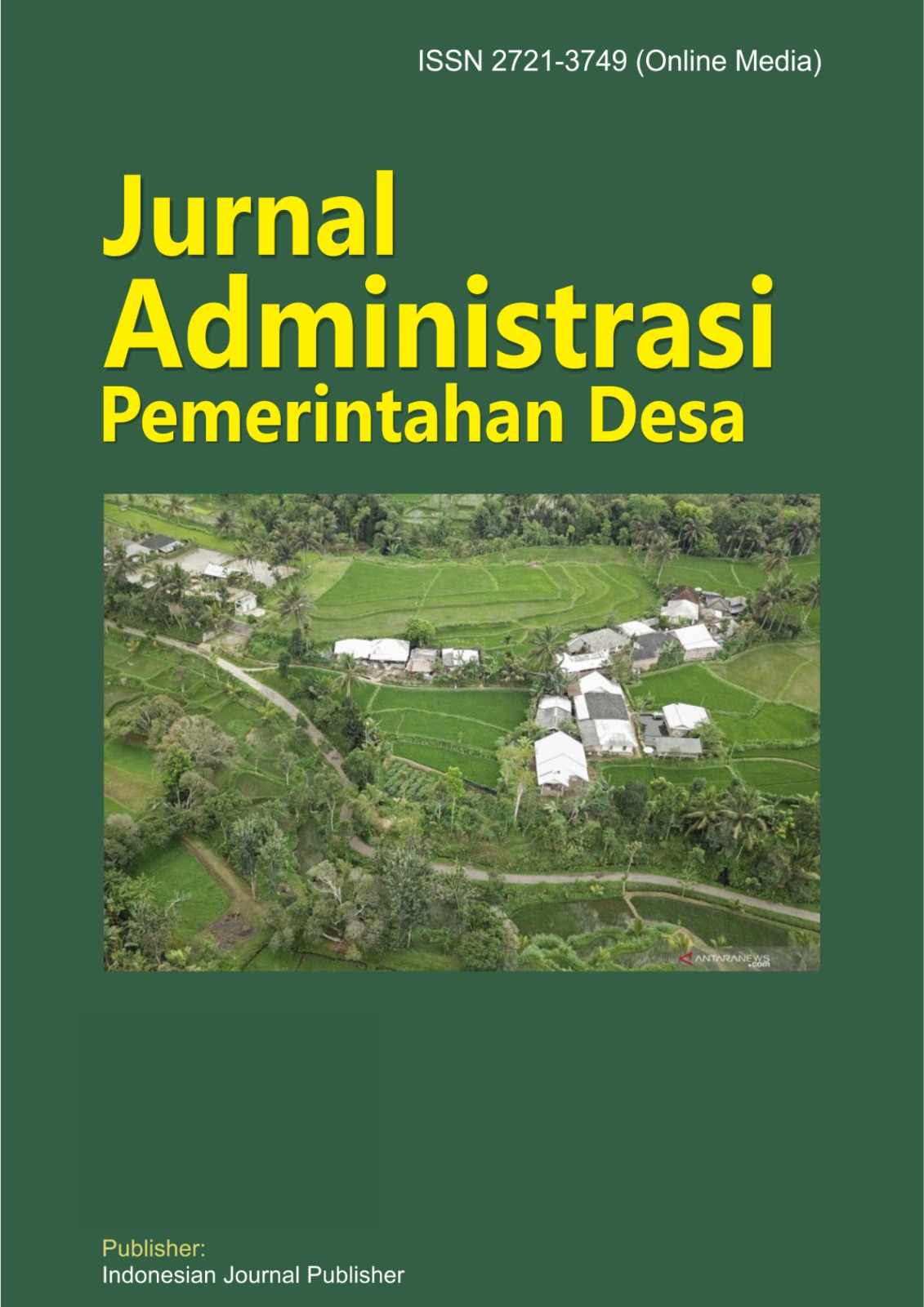Pengaruh Persepsi Terhadap Partisipasi Lansia Pada Program Posyandu Lansia di Nagari Matua Hilia
DOI:
https://doi.org/10.47134/villages.v4i2.55Keywords:
Persepsi, Partisipasi, Posyandu LansiaAbstract
Artikel ini bertujuan mengetahui pengaruh persepsi terhadap partisipasi lansia pada kegiatan posyandu lansia di Nagari Matua Hilia. Tulisan ini dilatarbelakangi oleh rendahnya partisipasi lansia dalam mengikuti kegiatan posyandu lansia, yang dapat dilihat dari rendahnya kehadiran lansia sekitar 9,1% lansia yang mengikuti kegiatan posyandu, rendahnya kehadiran lansia mengikuti kegiatan senam serta terdapat pemikiran yang salah diantara lansia terkait kegiatan posyandu. Dalam tulisan ini bertujuan untuk mengetahui seberapa besar pengaruh persepsi terhadap partisipasi serta faktor apa saja yang mampu mempengaruhi partisipasi lansia dalam program posyandu lansia. Metode yang digunakan adalah penelitian kombinasi (mixed method) dengan model sequentional explanatory. Dilakukan penyebaran angket kepada 84 lansia di Nagari Matua Hilia serta dilakukan wawancara dengan beberapa pihak terkait program posyandu lansia. Hasil penelitian menunjukkan bahwa, terdapat faktor internal dan eksternal yang mempengaruhi partisipasi lansia. Faktor internal tersebut dipengaruhi oleh kesadaran, pemahaman dan budaya yang melekat dalam kehidupannya. Sedangkan faktor eksternal dipengaruhi oleh, pendidikan, pekerjaan, kondisi kesehatan serta dorongan keluarga.
References
Aguila, E., Kapteyn, A., & Smith, J. P. (2015). Effects of income supplementation on health of the poor elderly: The case of Mexico. Proceedings of the National Academy of Sciences of the United States of America, 112(1), 70–75. https://doi.org/10.1073/pnas.1414453112
Bahari, G. (2021). Analisis faktor – faktor yang mempengaruhi kesejahteraan lansia di Kecamatan Karangasem. Fakultan ekonomi dan bisnis. Universitas Udayana.
Bartoletti, R., & Faccioli, F. (2016). Public Engagement, Local Policies, and Citizens’ Participation: An Italian Case Study of Civic Collaboration. Social Media and Society, 2(3). https://doi.org/10.1177/2056305116662187
Belousov, E. I., Gornev, R. V, & Mikheeva, T. N. (2015). About participation of institutes of civil society in public control over the activities of local authorities. Review of European Studies, 7(8), 59–64. https://doi.org/10.5539/res.v7n8p59
Deng, F.-H., Gao, Y.-H., & Tian, Q.-L. (2020). Effects of ecotourism travel motivation and social relations on mental state of the middle-aged and elderly group. Revista de Cercetare Si Interventie Sociala, 70, 20–30. https://doi.org/10.33788/rcis.70.2
Fonchingong, C. (2017). Shoring up local development initiatives: Elderly elite and conscientised empowerment in Cameroon. International Development Planning Review, 39(2), 123–142. https://doi.org/10.3828/idpr.2016.25
Fotokian, Z., Shahboulaghi, F. M., Fallahi-Khoshknab, M., & Pourhabib, A. (2017). The empowerment of elderly patients with chronic obstructive pulmonary disease: Managing life with the disease. PLoS ONE, 12(4). https://doi.org/10.1371/journal.pone.0174028
He, J., & Zhu, J. (2022). Key Drivers of the Emergency Capabilities of Integrated Elderly Services Supply Chains. Information Resources Management Journal, 35(1). https://doi.org/10.4018/IRMJ.291525
Hepburn, P. A. (2018). A new governance model for delivering digital policy agendas: A case study of digital inclusion amongst elderly people in the UK. International Journal of E-Planning Research, 7(3), 36–49. https://doi.org/10.4018/IJEPR.2018070103
Joarder, T., Cooper, A., & Zaman, S. (2014). Meaning of Death: An Exploration of Perception of Elderly in a Bangladeshi Village. Journal of Cross-Cultural Gerontology, 29(3), 299–314. https://doi.org/10.1007/s10823-014-9237-6
Julaihi, F. A., Mohamad Bohari, A. A., Azman, M. A., Kipli, K., & Amirul, S. R. (2022). The Preliminary Results on the Push Factors for the Elderly to Move toJurnal Administrasi Pemerintahan Desa (Village) Vol 04 No 02 Agustus 2023 (159-172) https://villages.pubmedia.id/index.php/villages/index Prefix 10.47134 171 Retirement Villages in Malaysia. Pertanika Journal of Social Sciences and Humanities, 30(2), 761–778. https://doi.org/10.47836/pjssh.30.2.18
Jung, I., Bloomfield, K., Hikaka, J., Tatton, A., & Boyd, M. (2022). “Making an effort for the very elderly”: The acceptability of a multidisciplinary intervention to retirement village residents. Health and Social Care in the Community, 30(6), e5356–e5365. https://doi.org/10.1111/hsc.13957
Liu, Z.-W., Yu, Y., Fang, L., Hu, M., Zhou, L., & Xiao, S.- Y. (2019). Willingness to receive institutional and community-based eldercare among the rural elderly in China. PLoS ONE, 14(11). https://doi.org/10.1371/journal.pone.0225314
Lu, S., Wu, F., Wang, Z., Cui, Y., Chen, C., & Wei, Y. (2021). Evaluation system and application of plants in healing landscape for the elderly. Urban Forestry and Urban Greening, 58. https://doi.org/10.1016/j.ufug.2020.126969
Menec, V. H. (2017). Conceptualizing Social Connectivity in the Context of Age-Friendly Communities. Journal of Housing for the Elderly, 31(2), 99–116. https://doi.org/10.1080/02763893.2017.1309926
Miller, N. A. (2005). State strategies to support community based long term care for the elderly. Journal of Health and Social Policy, 20(4), 1–30. https://doi.org/10.1300/J045v20n04_01
Nillaor, P., Sriwichian, A., Wanichsombat, A., Kajornkasirat, S., Boonjing, V., & Muangprathub, J. (2022). Development of Elderly Life Quality Database in Thailand with a Correlation Feature Analysis. Sustainability (Switzerland), 14(8). https://doi.org/10.3390/su14084468
Park, J., & Kim, K. (2016). The residential location choice of the elderly in Korea: A multilevel logit model. Journal of Rural Studies, 44, 261–271. https://doi.org/10.1016/j.jrurstud.2016.02.009 Safarik, M. E., & Wurtz, D. G. (2006). Investigation, science, and research partner to solve elderly woman’s shocking homicide. Journal of Forensic Nursing, 2(3), 127–129. https://doi.org/10.1097/01263942- 200609000-00004
Senbil, M., & Yetiskul, E. (2022). Spatial variation of elderly population and its dynamics in Turkey. Population, Space and Place, 28(3). https://doi.org/10.1002/psp.2516
Shamim Talukder, Md., Chiong, R., Corbitt, B., & Bao, Y. (2020). Critical factors influencing the intention to adopt m-government services by the elderly. Journal of Global Information Management, 28(4), 74–94. https://doi.org/10.4018/JGIM.2020100105
Smets, A. J. H. (2012). Housing the elderly: Segregated in senior cities or integrated in urban society? Journal of Housing and the Built Environment, 27(2), 225–239. https://doi.org/10.1007/s10901-011-9252-7
Suzuki, K., Dollery, B. E., & Kortt, M. A. (2021). Addressing loneliness and social isolation amongst elderly people through local co-production in Japan. Social Policy and Administration, 55(4), 674–686. https://doi.org/10.1111/spol.12650
Utomo, A., Mcdonald, P., Utomo, I., Cahyadi, N., & Sparrow, R. (2019). Social engagement and the elderly in rural Indonesia. Social Science and Medicine, 229, 22–31. https://doi.org/10.1016/j.socscimed.2018.05.009
Viñarás-Abad, M., Abad-Alcalá, L., Llorente-Barroso, C., Sánchez-Valle, M., & Pretel-Jiménez, M. (2017). EAdministration and the e-inclusion of the elderly. Revista Latina de Comunicacion Social, 72, 197–219. https://doi.org/10.4185/RLCS-2017-1161
Warming, H. (2019). Trust and Power Dynamics in Children’s Lived Citizenship and Participation: The Case of Public Schools and Social Work in Denmark. Children and Society, 33(4), 333–346. https://doi.org/10.1111/chso.12311
Zubaedi. (2011). Desain Pendidikan Karakter. Kencana Penada Media Group.
Downloads
Published
How to Cite
Issue
Section
License
This journal is based on the work at https://villages.pubmedia.id/index.php/villages under license from Creative Commons Attribution-ShareAlike 4.0 International License. You are free to:
- Share – copy and redistribute the material in any medium or format.
- Adapt – remix, transform, and build upon the material for any purpose, even commercially.
The licensor cannot revoke these freedoms as long as you follow the license terms, which include the following:
- Attribution. You must give appropriate credit, provide a link to the license, and indicate if changes were made. You may do so in any reasonable manner, but not in any way that suggests the licensor endorses you or your use.
- ShareAlike. If you remix, transform or build upon the material, you must distribute your contributions under the same license as the original.
- No additional restrictions. You may not apply legal terms or technological measures that legally restrict others from doing anything the license permits.
Information for authors
The author should be aware that by submitting an article to this journal, the article's copyright will be fully transferred to Jurnal Administrasi Pemerintahan Desa. Authors are allowed to resend their manuscript to other journals or intentionally withdraw the manuscript only if both parties (Jurnal Administrasi Pemerintahan Desa and Authors) have agreed on the issue. Once the manuscript has been published, authors are allowed to use their published article under Jurnal Administrasi Pemerintahan Desa copyrights.
All authors are required to deliver the agreement of license transfer once they submit the manuscript to Jurnal Administrasi Pemerintahan Desa. By signing the agreement, the copyright is attributed to this journal to protect the intellectual material for the authors. Authors are allowed to share, copy and redistribute the material in any medium and in any circumstances.
• Creative Commons Attribution-ShareAlike (CC BY-SA)

Jurnal Administrasi Pemerintahan Desa is licensed under an International License










